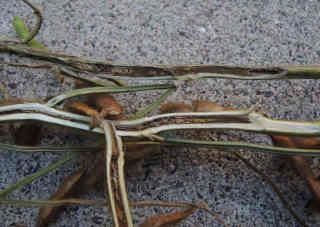By Sam Markell
This page was adapted from the article, "Brown Stem Rot of Soybeans (BSR)," which appeared in Crop & Pest Report on August 25, 2022.
Brown stem rot is known to occur in the state, although the exact prevalence is unknown. Like SDS, BSR is often more damaging when soybean cyst nematode (SCN) is present. Like many diseases, BSR is favored by short/no crop rotation.
Brown stem rot is caused by a fungal pathogen (Cadophora gregata), that can overwinter/survive in infected soybean stem residue. Infection occurs through the roots in the spring and moves into the stem, impacting the movement of nutrients and water in the plant.
Foliar symptoms do not always occur with BSR, however, if they do they often mimic the interveinal chlorosis seen with SDS. Examination of the stem is critical for identification of BSR. Brown stem rot causes a distinct browning of the pith, while the rest of the tissue will appear white and health. The symptom resembles a ‘lead in a pencil’ look (Figure 1).

Figure 1. Lower stem symptoms of Brown Stem Rot (BSR).
Source : ndsu.edu